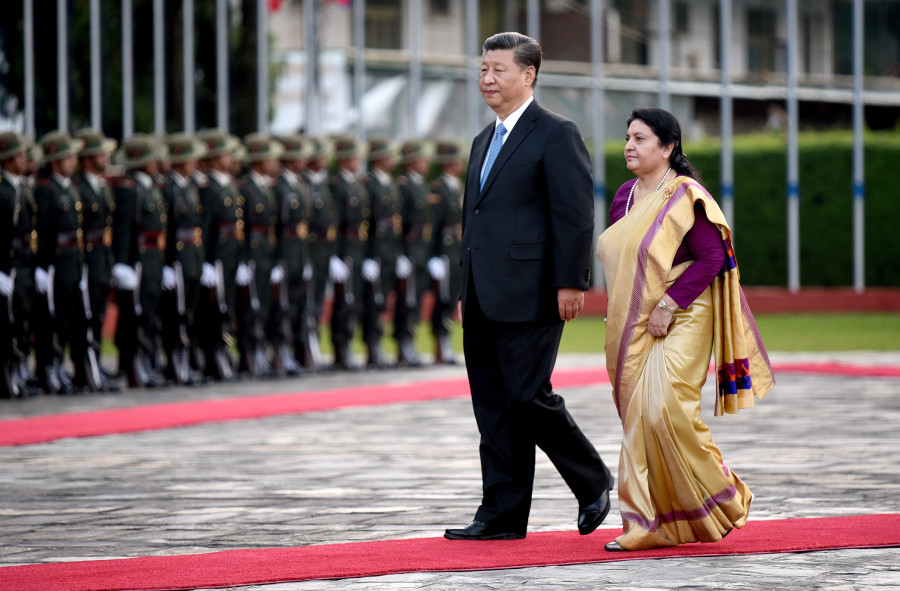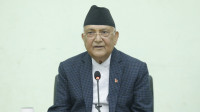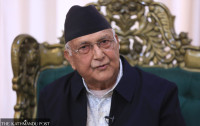Politics
Xi arrives, heralding the rise of an influential geopolitical actor in Nepal
The visit of the Chinese President might come with material benefits for Nepal but it is laden with geostrategic symbolism, analysts say.
Binod Ghimire
It was more than two decades ago that a Chinese president last crossed the Himalayas and landed in Kathmandu. But on Saturday, Xi Jinping did not cross the Himalayas, he flew over the Tarai plains—straight from Chennai, India, after the second informal summit with Indian Prime Minister Narendra Modi.
While Xi’s visit, the first by a sitting Chinese president after 23 years, no doubt holds great significance for Nepal, analysts say it is up to Nepal to make the most out of China’s goodwill, which may come with strings attached.
As far as Beijing is concerned, it is clear about its foreign policy, how it wants to expand its influence in South Asia and beyond, and what measures it will take to broaden the reach and appeal of Xi’s ambitious Belt and Road Initiative (BRI). But in the past week, South Asia was on Xi’s mind.
Just before flying to Chennai on Friday, Xi welcomed Imran Khan, the prime minister of Pakistan. In the aftermath of New Delhi’s August 5 decision to strip Kashmir of its autonomous status, Beijing and Islamabad appeared to be on the same page, much to India’s chagrin. The meeting between Xi and Modi too materialised after some level of uncertainty.
But in Kathmandu, despite no official communication from Beijing regarding Xi’s visit until just a few days earlier, preparations to welcome the Chinese president were underway a fortnight ago. China has been Nepal’s all-weather friend, but despite enjoying over six decades of diplomatic ties, high-level visits from the north have been sparse.
That’s one reason why Xi’s visit is a watershed moment in Nepal-China ties, say analysts.
"Xi’s visit definitely takes China-Nepal relations to a new stage,” said Ajaya Bhadra Khanal, a political analyst who is also a columnist for the Post. “The visit is a positive response from China.”
Khanal, however, did not miss the symbolism of Xi’s arrival from across the plains.
“Nepal wants China to look at Kathmandu without bringing in New Delhi, but Xi arrived straight from India. So doubts persist,” he said.
This long overdue visit from a friendly neighbour was not particularly due to China’s unwillingness to engage with Nepal on a high level, say foreign policy watchers. It was largely due to political instability in Nepal. The 2015 constitution and the 2017 elections have brought about a semblance of stability in Nepal, installing a strong government that is largely seen as much more open to engagement with China.
Political stability certainly paved the way for a visit, but Nepal’s concerns are more material.
Constantino Xavier, a foreign policy fellow at the Brookings India, a think tank in New Delhi, said that Nepal seeks greater connectivity with China to reduce its reliance on India, whether on trade, energy security or digital connectivity.
“This also explains the strategic debate within the Nepali government, between those arguing for China’s BRI and a northward focus to Tibet, across the Himalayas, and those who have made a case for diversification by linking Nepal southwards, beyond India, to the Bay of Bengal region and the Indo-Pacific,” Xavier told the Post in an email interview.
Nepal has signed up for the BRI but India has cautiously refrained from taking part.
Unlike India, Nepal lacks the economic and geopolitical heft to abstain from a project as ambitious as the BRI. China is a global power and Xi one of the most powerful leaders in the world. China has engineered an economic boom in recent years, while the United States and Europe were licking their wounds after financial crises. With the West, particularly the US, wringing its hands regarding China’s rise, American President Donald Trump has launched a trade war against China.
But Beijing is not naive. It knows that the US move is not just about trade, say analysts. For China, this is a good moment to shore up its backyard.
“Economy and security are the two factors that China is concerned with,” said Khanal. “Taking neighbours along is a must for China, which has as an aspiration to expand its influence globally.”
According to Khanal, how Nepali politicians carry forward their foreign policy will also decide Nepal’s future course.
“Foreign policy must not become a tool for domestic politics,” he said. “But unfortunately, the Nepal Communist Party and its leaders are trying to benefit politically from their relations with China.”
Prime Minister KP Sharma Oli won the 2017 elections on the back of nationalist posturing against India, which had just imposed a months-long economic blockade when Nepal was still reeling from devastating earthquakes. Oli played up ties with China as a counter-balance to Nepal’s unhealthy dependence on India, even signing a transit and transport agreement with the northern neighbour. India has not been particularly pleased with these developments, especially since it has long considered Nepal to be within its sphere of influence.
But India isn’t the only country watching Nepal in its pursuit of China. The US, which has long been wary of a rising China, has time and again cautioned Nepal against Chinese goodwill, sometimes bluntly. During their visits to Nepal, American officials have reminded Nepali leaders that any assistance from the north should be in Nepal’s interest, not China’s. Even though they have stopped short of mentioning the Belt and Road Initiative, their references to Sri Lanka and some African countries, which have fallen into what the West calls a “debt trap”, clearly demonstrate what they mean. The Chinese have been quick to counter such statements and they maintain that the Belt and Road Initiative is meant for shared benefits.
The US has also included Nepal in its broad Indo-Pacific Strategy. Even though American officials have attempted to qualify that the strategy is not targeted at any particular country, many, including the Chinese, see it as an attempt to counter China.
An article in The Global Times, the mouthpiece of the Communist Party of China, on Wednesday said that Xi’s visit to India would improve China’s ties with the South Asian country and also “serve as a response to the Indo-Pacific Strategy intended to contain China”.
In this tussle between the great powers, Nepal is a footnote, but its geostrategic location gives its an edge that belies its small stature.
“Chinese support for infrastructure and foreign direct investment is what Nepal is looking forward to,” said Tanka Karki, a former Nepali ambassador to China. “At the same time, it is an opportunity to show Nepal is China’s trusted neighbour.”
Connectivity with China would not just benefit Nepal but also the region, which is in the shared interest of everyone, including China and India, who aim to take their bilateral trade over the $100 billion mark by the end of the year.
Railway connectivity to India via Nepal is certainly in China’s interest, analysts say.
“After the Wuhan normalisation, China has been insistently advocating trilateral connectivity or infrastructure projects with India, which Beijing calls the ‘India-China plus one’ model,” said Xavier. “Recognising Indian concerns about the BRI and its projects in PoK [Pakistan-occupied Kashmir], China has been testing India’s openness to develop a Himalayan economic and transportation corridor between India, Nepal and China.”
The cross-border railway is high on the Xi visit agenda. While there is euphoria among Nepalis regarding a rail link to China, a railway across the Himalayas, by their own admission, will be a test for China’s technological might.
While there are sections in Kathmandu that caution Nepal against falling into a debt trap over a train line, ruling party leaders have rejected the notion of a debt trap wholesale, saying it is an “imported notion”, created by westerners. The experience of many African countries, however, says otherwise. Even China itself is “recalibrating” its BRI in response to criticisms of creating indebtedness among poorer nations.
Nevertheless, around a dozen agreements related to connectivity, infrastructure and hydropower are expected to be signed during Xi’s 20-hour stay in Kathmandu. But more than the material, Xi’s presence in Kathmandu is laden with symbolism.
“More than a few projects Xi is expected to inaugurate or announce, his visit marks the rise of China as an influential political actor in Nepal,” said Xavier. “Beyond financing, China has been silently cultivating a new generation of Nepali politicians, journalists and scholars through public diplomacy and exchange programmes.”
Xi’s visit to Nepal follows a two-day symposium on “Xi Jinping Thought on Socialism with Chinese Characteristics for a New Era” in Kathmandu, which was attended by leaders of the ruling Nepal Communist Party (NCP), including Prime Minister Oli.
“The recent workshop conducted in Kathmandu for ruling party members indicates Beijing is using its sharp power to shape the politics and institutions of one of Asia’s least developed democracies,” said Xavier.
But amid all these maneuverings, what is important for Nepal is how it maintains its autonomy, say analysts. Nepali politicians should make prudent moves and exhibit deft diplomacy to make the most of its friendly nations.
“Nepal should be able to maintain its strategic autonomy,” said Khanal. “Relations must be transparent to ensure other friendly nations aren’t skeptical.”
With Xi’s arrival, however, the consensus is that the Oli administration has pulled off a coup by materialising a visit from the northern neighbour.
“In the contemporary world where China is expanding its role, Xi’s visit has huge diplomatic and strategic meaning with long-term implications,” said Ramesh Nath Pandey, a former foreign minister. “Traditional and ritualistic diplomacy has been replaced with direct and tactical diplomacy.”
According to Pandey, while deals on infrastructure and other support from the Chinese side matter, what’s more significant is how the one-on-one meeting between Prime Minister Oli and President Xi moves ahead.
“That meeting will pave the future course of the Nepal-China relationship,” said Pandey.
Given how the meeting goes, the next time there is a high-level visit from China, perhaps it won’t come through the south.
Anil Giri contributed reporting.
***
What do you think?
Dear reader, we’d like to hear from you. We regularly publish letters to the editor on contemporary issues or direct responses to something the Post has recently published. Please send your letters to [email protected] with "Letter to the Editor" in the subject line. Please include your name, location, and a contact address so one of our editors can reach out to you.




 5.15°C Kathmandu
5.15°C Kathmandu















